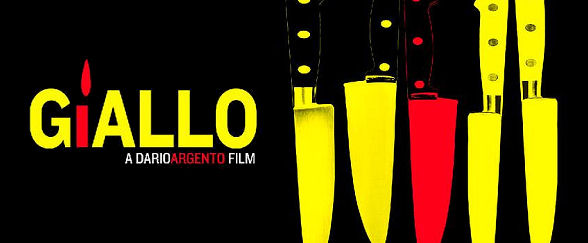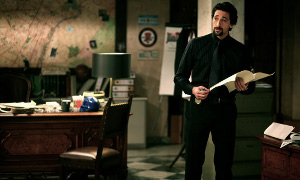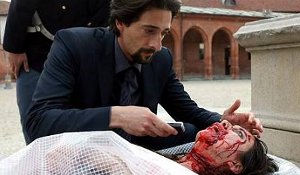
As detractors often like to comment, Dario Argento’s glory days are long behind him. Once the most respected filmmaker in his native Italy, the likes of Deep Red and Suspiria would later give way to such ill-advised efforts as The Phantom of the Opera and Do You Like Hitchcock?. His last offering, Mother of Tears, had been highly anticipated but due to the mishandling by the studio the movie failed to re-ignite his career as fans had hoped. Returning to the genre that had served him best, Giallo shows the director once again exploring similar territory to his earlier work, combining a slasher-style villain with a poliziesco detective thriller.
 Giallo would mark the feature debut of writers Jim Agnew and Sean Keller, devised as an homage to their favourite director. By chance it found its way onto his desk, its story of a deranged serial killer preying on beautiful, young women immediately recalling the genre which he had helped popularise in the early seventies. Whilst his attempts at exploring the supernatural had mostly failed, each time he had returned to the giallo formula fans and critics would take notice once again.
Giallo would mark the feature debut of writers Jim Agnew and Sean Keller, devised as an homage to their favourite director. By chance it found its way onto his desk, its story of a deranged serial killer preying on beautiful, young women immediately recalling the genre which he had helped popularise in the early seventies. Whilst his attempts at exploring the supernatural had mostly failed, each time he had returned to the giallo formula fans and critics would take notice once again.
The film opens with two Japanese girls leaving an opera in the hope of finding some excitement, eventually making their way to a disco. With her friend preoccupied with a man on the dance floor, Keiko (Valentina Izumi) decides to head back to the hotel, but with rain pouring down heavily she tries to catch a taxi. Realising that she is being taken the wrong way, the cab soon heads down a deserted road where the driver pulls over. A moment later, he pounces and manages to overpower her.
What is immediate about the film is the dramatic and dominating score by Marco Werba, which constantly builds tension before any action takes place. At this point, the killer is obscured in the darkness, only his menacing eyes are made visible through the rear view mirror. Keiko is taken to an isolated location where she is strapped down in what resembles the kind of torture room one would expect to find in Hostel.
 The next introduction is Celine (Elsa Pataky), an attractive young catwalk model. Her older sister, Linda (Emmanuelle Seigner), has come to visit her and decides to wait at her apartment. But on her way back home, Celine has the misfortune of catching the same taxi as Keiko and soon finds herself in the basement with the killer’s other victim. Unfortunately, perhaps the film’s greatest weakness is its antagonist, portrayed by Byron Deidra, who seems to resemble a bizarre cross between John Merrick and Bruce Springsteen. Whilst such perverse behaviour as sucking on a child’s dummy and masturbating to photographs of his victims may have been intended as disturbing, it simply comes across as ridiculous and comical.
The next introduction is Celine (Elsa Pataky), an attractive young catwalk model. Her older sister, Linda (Emmanuelle Seigner), has come to visit her and decides to wait at her apartment. But on her way back home, Celine has the misfortune of catching the same taxi as Keiko and soon finds herself in the basement with the killer’s other victim. Unfortunately, perhaps the film’s greatest weakness is its antagonist, portrayed by Byron Deidra, who seems to resemble a bizarre cross between John Merrick and Bruce Springsteen. Whilst such perverse behaviour as sucking on a child’s dummy and masturbating to photographs of his victims may have been intended as disturbing, it simply comes across as ridiculous and comical.
When Celine fails to return home, Linda heads to the police station, where she is confronted by an unhelpful desk sergeant. Eventually, she is sent downstairs to the office of Inspector Avolfi (Adrien Brody), an unorthodox and strange cop who is heading the investigation of young women who had recently fallen foul of the same maniac. Surprisingly, Brody delivers an excellent performance as the moody and mysterious Avolfi, constantly chain-smoking and scenery-chewing his way through the movie. I have never been a fan of his before but I was impressed by his intensity and deadpan humour. Unfortunately, the same cannot be said for Seigner, who seems to sleepwalk through her role with little emotion or conviction.
Those wondering why this film is called Giallo may be enlightened if they have a minor understanding of Italian. ‘Giallo’ means yellow, and was named after the thriller novels of the thirties and forties which came with bright yellow covers. But the title of the film also refers to the killer, who was blessed with the nickname Yellow by cruel children who had teased him because of the sickening colour of his skin, which had been caused by a liver disease. His mother had been a drug addict and had remained a user during her pregnancy, only to abandon the baby at a convent soon after his birth.
 He is not the only character to have a complex past. Avolfi has spent his life tortured by the events of his childhood, in which he had witnessed the brutal murder of his mother. Years later, when he had returned from New York, the teenage boy had finally tracked down the man responsible and carried out a savage revenge. In some ways, Brody’s performance somewhat echoes Liam Cunningham’s in The Card Player, in which he had played a British agent tracking down a serial killer who was targeting beautiful women. He would certainly prove more competent than many of Argento’s other cop characters, such as Deep Red‘s Supt. Calcabrini and Tenebrae‘s Detective Giermani.
He is not the only character to have a complex past. Avolfi has spent his life tortured by the events of his childhood, in which he had witnessed the brutal murder of his mother. Years later, when he had returned from New York, the teenage boy had finally tracked down the man responsible and carried out a savage revenge. In some ways, Brody’s performance somewhat echoes Liam Cunningham’s in The Card Player, in which he had played a British agent tracking down a serial killer who was targeting beautiful women. He would certainly prove more competent than many of Argento’s other cop characters, such as Deep Red‘s Supt. Calcabrini and Tenebrae‘s Detective Giermani.
Whilst Giallo may lack originality or that classic Argento feel, it is still an enjoyable, if flawed, experience. The cinematography is seductively shot by Frederic Fasano and the gore is plentiful; with slit throats, crushed skulls and severed lips contributing to the blood flow. Once again, most of the victims are beautiful women which may provoke the usual accusations of misogyny, but Avolfi’s utter disgust at the killer’s actions steers the film away from simple exploitation.
 Many of the usual flaws that have dogged his work over the last twenty-five years are thankfully absent, such as awful dubbing and an annoying heavy metal soundtrack. But, as with many Argento thrillers, the greatest disappointment is the villain, who seems too pantomime-like to be genuinely scary. And whilst he becomes more sympathetic as his character develops, the film works better when he is not on screen. Giallo‘s greatest assets are without a doubt Brody and Werba, both of whom deliver exactly what is needed, and whilst this is unlikely to win over those who feel that Argento has had his day, it boasts enough interesting ideas to warrant a viewing.
Many of the usual flaws that have dogged his work over the last twenty-five years are thankfully absent, such as awful dubbing and an annoying heavy metal soundtrack. But, as with many Argento thrillers, the greatest disappointment is the villain, who seems too pantomime-like to be genuinely scary. And whilst he becomes more sympathetic as his character develops, the film works better when he is not on screen. Giallo‘s greatest assets are without a doubt Brody and Werba, both of whom deliver exactly what is needed, and whilst this is unlikely to win over those who feel that Argento has had his day, it boasts enough interesting ideas to warrant a viewing.

11 Responses to Dario Argento’s Giallo (2009) EXCLUSIVE REVIEW!